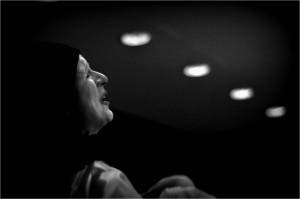We know that museums make decisions about how they represent history, and how they allow their visitors to access and experience it. In the last of our posts this week about Liverpool’s museums, we visit Liverpool’s World War 2 Museum, Western Approaches, which is discreetly concealed on Rumford Street, just behind Exchange Flags.
The museum is housed in Western Approaches Command, which opened in 1941 as the top secret command centre monitoring and directing the Atlantic Convoys. Even the builders working on Derby House, in the basement of which this wartime bunker was based, were unaware of the ultimate purpose of the building, and throughout its operation during the war anyone entering had to sign the Official Secrets Act. Some 300 staff worked, ate, and slept in these underground rooms.
Again, there is a direct link with Whose History?. Our film ‘Hey Joe’ takes place at the site which inspired it, the Black Merchant Seamen’s Memorial in Falkner Square Gardens. The memorial was campaigned for by Joe Farrag, whose grandfather, Ali Hussein Farrag, was a merchant seaman, who was killed in May 1943 during the Battle of the Atlantic. Ali lived on Pitt Street in Liverpool 1. His family home was a short distance from Western Approaches Command, where senior military personnel plotted out the course of ships like Ali’s, the SS Fort Concorde, and the vessels alongside which they sailed.
Staff left Western Approaches for the last time on 15 August 1945, and in the subsequent decades the space was largely untouched, gradually falling into disrepair, until the museum was opened in 1993. It is still described as a work in progress, as restoration continues to make more and more of this labyrinthine space accessible to visitors.
The curatorial approach taken by the museum is immersive and atmospheric. Visitors enter the bunker and see its many rooms as the original occupants would have experienced them. In the Operations Room, with its vast map of the Atlantic, Top Secret documents can be seen on the desks. In Admiral Sir Max Horton’s Office, a cigar lies in the ashtray. One of the sparsely furnished bunk rooms is dressed as a sleeping quarters for female officers; a pair of shoes is placed neatly underneath one end of the bed.
Throughout the museum, interpretative information boards explain what we are seeing, where we are standing, and how the course of the war was affected by the work of the people who once filled this secret space. But sometimes the more personal characters of those people seem to be come, however briefly, into view. A key cupboard is affixed to a wall behind a desk outside one of the main entrances to the heart of the bunker – a metal door next to which permanently armed members of the Royal Marines would have been stationed. An example of a Marines uniform is on display for visitors to see, next to coat hooks where a uniform jacket has been hung, as if by the man on duty. The doors of the cupboard are open, and the original, carefully labelled keys are still hung up in rows, as if untouched since the 1940s. Also, it would seem, untouched and surviving, is the magazine photograph of a pin-up model, pasted on to the inside of one of the cupboard doors, and still smiling out at anyone who meets her gaze.

